In the last issue of Woodland Wanderings, we described the first phase of our studies on the restoration of woodland groundlayers. We were seeking to explain why the groundlayers of grazed and degraded remnants rarely recover well after fencing and livestock exclusion. We compared the topsoils of a range of degraded and undisturbed remnants, and found that undisturbed remnants are extremely low in soil nitrate (one of the most important forms of available nitrogen used for plant growth), while progressively weedier sites were progressively higher in soil nitrate.
Informed by these results, we established some groundlayer restoration trials at two woodland remnants near Young in Central NSW. Our aims were to promote native grasses and deplete annual weeds. The groundlayer of one remnant was almost entirely dominated by weedy annual grasses and Paterson's Curse (Echium plantagineum), while the other had an equal mix of weedy annuals and native perennial grasses, particularly Red Grass (Bothriochloa macra). We planned a three-pronged approach, aiming to reduce weed growth by reducing soil nitrate levels, to reduce weed seed banks by removing the standing weed crop before it set seed, and to enhance native grass establishment by adding native grass seed.
So first, how might we reduce soil nitrate levels? There is an enormous quantity of information on how to increase soil nitrogen to improve crop growth, but very little on doing the reverse. One way might be to remove nitrogen by removing the standing crop of lush green weeds, by burning, slashing or grazing during spring. We took this approach by burning in mid-October. This did not appear to reduce soil nitrate in the short-term at least (Figure 1, although it had other positive effects; see below).
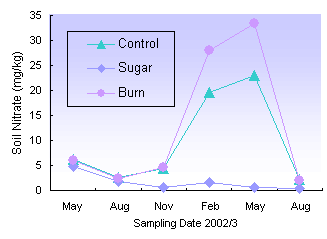 Another method we tried was to increase the carbon:nitrogen ratio in the soil by adding carbohydrate. Most farmers will be aware that crop stubble can temporarily reduce plant growth because soil microorganisms that break down the stubble use up available soil nitrogen. So we tried the same thing by adding sugar, a faster acting form of carbon than crop stubble, hoping to reduce weed growth and thus reduce their competition with the natives.
Another method we tried was to increase the carbon:nitrogen ratio in the soil by adding carbohydrate. Most farmers will be aware that crop stubble can temporarily reduce plant growth because soil microorganisms that break down the stubble use up available soil nitrogen. So we tried the same thing by adding sugar, a faster acting form of carbon than crop stubble, hoping to reduce weed growth and thus reduce their competition with the natives.
Right: Figure 1. Soil nitrate levels over a 15 month period in a grassy White Box woodland remnant near Young. Half a kilogram of sugar per square metre was added every three months to sugar plots, bum plots were burnt in October 2002 and control plots were untreated.
We found that adding half a kilogram of sugar per square metre every three months almost eliminated soil nitrate during the autumn, and dramatically reduced the growth of all annual weeds (Figures 1 & 2).
Our second aim was to reduce weed seed banks. This was attempted using the same two treatments, burning and carbohydrate addition. Spring burning effectively removed the entire year's seed crop of cool season annuals, and this in turn led to a dramatic reduction in the abundance of annual grass weeds the next spring (Figure 2). However, broad-leafed weeds like Paterson's Curse did well after the bums, probably because they have longer-lived seed banks than the grasses. The dramatic reduction in weed growth resulting from the sugar treatments is likely to have also reduced seed set in these weeds. However, even very small plants were able to set seed, providing some replenishment of the weed seed bank.
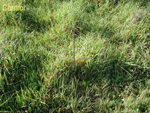
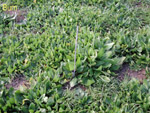
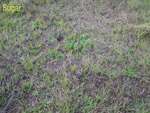
Above: Figure 2. Early effects of burning and sugar addition on annual weeds in a site initially dominated by Wild Oats (Avena spp.), bromes (Bromus spp.) and Patersons' Curse (Echium plantagineum).
The aim of reducing soil nitrate and the weed seed bank was to give us a window of opportunity to establish native grasses while the weeds were suppressed. For this, we added seed of Kangaroo Grass (Themeda australis) and Snow Grass (Poa sieberiana), the two original native grass dominants of the grassy White and Yellow Box woodlands. Unfortunately this was during the severe drought of 2002-3, and no Snow Grass plants successfully established. Surprisingly, Kangaroo Grass established after a short period of good rain in February 2003, and some plants survived despite prolonged dry periods in the following autumn and winter.
Kangaroo Grass established very sparsely on untreated plots that still had a thick layer of dead annual weeds. Establishment was enhanced by the sugar treatments, and was most successful on burnt plots (Figure 3).
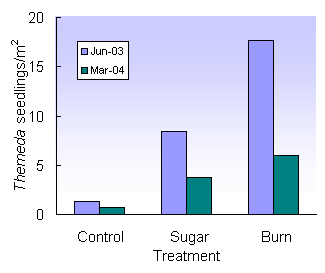 Two years after the beginning of these trials, the best of our experimental plots are beginning to resemble native grassy swards. Best results were obtained when Kangaroo Grass seed was added to plots that were burnt or 'sugared'. Plots without Kangaroo Grass seed were generally poorer in quality, and were very variable, depending on whether any other native plant seeds were already present to replace the weeds.
Two years after the beginning of these trials, the best of our experimental plots are beginning to resemble native grassy swards. Best results were obtained when Kangaroo Grass seed was added to plots that were burnt or 'sugared'. Plots without Kangaroo Grass seed were generally poorer in quality, and were very variable, depending on whether any other native plant seeds were already present to replace the weeds.
Right: Figure 3. Establishment of Kangaroo Grass on untreated plots was poorer than on burnt plots and plots with sugar added. Loss of seedlings on burnt plots later in the season was due to an extended dry period.
As the Kangaroo Grass plants become more established in our plots, we hope to monitor whether this species can maintain low soil nitrate levels without further sugar additions, thus providing a long-term resistance to annual weeds. As well, we hope to add more diversity to the plots by adding seeds of the many native wildflowers that were once common in these woodlands.
Carbohydrate addition and spring burning show promise for restoring many degraded woodland groundlayers, and we suspect that a combination of burning plus carbohydrate addition (which we didn't try) may be even more effective. They are likely to be most effective where annual grasses are the dominant weeds, as is the case in many Box woodland remnants in winter-rainfall areas. However, they won't be appropriate for restoring all remnants. A different strategy will be needed where invasive perennial weeds such as Coolatai Grass (Hyparrhenia hirta) are the main problem. For remnants that retain few native plants in the ground layer, cultivation and sowing of native seed may be a more efficient option if the site is easily ploughed, but carbohydrate addition may still assist establishment of natives by reducing the nutrient pulse after cultivation and subsequent weed competition.
Good spring burns can be difficult to achieve when weeds are actively growing and there's little dry fuel. We sprayed the weeds with a contact (non-systemic) herbicide, then burnt them using a gas-powered weed burner once the top growth had dried off. This could easily be scaled up for broadscale restoration. An advantage of spring burning is that it is very safe as the rest of the country is still green. It's important though, that burns are undertaken in patches only, to minimize soil erosion and to retain habitat for native fauna. Short duration, high intensity grazing or slashing are other possible methods to reduce seed-set in annual grasses, but we don't know how these techniques will affect soil nitrate levels.
Our results are preliminary, but very exciting. We were able to reduce soil nutrients and weeds and promote native grasses in two remnants within two years, using very simple techniques. Clearly further trials are needed to investigate how well this approach works across a wide range of sites, to identify cheaper forms of carbohydrate (refined white sugar is probably the most expensive form available!), and to develop practical ways to 'scale-up' the method so it can be used across larger areas. With further R&D, our sweet restoration recipe may provide a simple, inexpensive way to restore many degraded Box Woodlands in the future.
This article was first published in Woodland Wanderings, Autumn 2004.